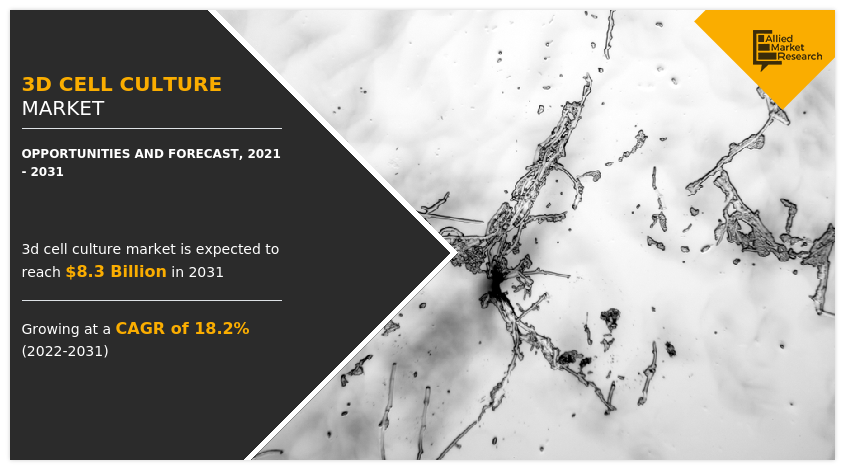3D Cell Culture Market Set for Exponential Growth, Predicted to Surpass USD 8.3 billion by 2031 | CA

In the field of biology research, cell culture plays a vital role. These cultures can be categorized into two main types, namely two-dimensional (2D) and three-dimensional (3D). Throughout the history of cell culture techniques, 2D cell cultures have been the preferred choice due to their easy availability, control over the environment, ability to observe and measure cells. However, growing cells in a flat layer on surfaces does not accurately replicate the in-vivo state. On the other hand, compared to 2D culture, 3D cell culture allows biological cells to grow and interact with their surroundings in a more realistic three-dimensional manner.

As per the latest research by Allied Market Research, the global market for 3D cell culture has been valued at $1.6 billion in 2021 and is predicted to reach $8.3 billion by 2031. This growth is expected to achieve a compound annual growth rate (CAGR) of 18.2% from 2022 to 2031. The report presents a comprehensive analysis of the most profitable investment opportunities, successful strategies, driving factors, market size and estimations, competitive landscape, and emerging trends. This study serves as a valuable source of information for industry leaders, newcomers, investors, and stakeholders in developing future strategies and enhancing their presence in the market.
Influence of the Covid-19 pandemic on the 3D cell culture industry:
Obtain a complimentary PDF report showcasing graphs and figures by clicking on the following link: https://www.alliedmarketresearch.com/request-sample/1474
What are the advantages of using the 3D Cell Culture Market?
The global market for 3D cell cultures is growing due to several factors. One advantage of using 3D cell cultures instead of traditional 2D cell cultures is the improved interactions between cells and the surrounding matrix. There is also ongoing research and development in the field of drug discovery, development, and screening, which contributes to the growth of this market. Additionally, there is a growing preference for using 3D cell cultures in cancer research, as well as an increased demand for organ transplantation.
Best 3D Cell Culture Techniques
3D Cell Culture Revolution: - The advancement of 3D cell culture techniques has brought about a significant transformation in the field.
The study presents a comprehensive breakdown of the worldwide 3D cell culture industry, taking into account various aspects such as the type of product, its applications, the target audience, and the geographical area. The report includes a thorough examination of each division and sub-division, accompanied by visual aids and statistical data. This analysis enables individuals involved in the market, including investors and newcomers, to identify the most promising sub-divisions to focus on for future expansion.
The scaffold based platforms category dominated the global 3D cell culture market in 2021, accounting for approximately 40% of the total market share. It is projected to maintain its leading position in the market during the forecast period. Additionally, the microchips segment is anticipated to exhibit the highest compound annual growth rate (CAGR) of 21.3% from 2022 to 2031. The study also evaluates other segments including scaffold-free platforms, gels, bioreactors, and services.
In terms of usage, the cancer research category dominated the global 3D cell culture market in 2021, constituting almost 33% of the market share, and is predicted to maintain its dominance until 2031. Nevertheless, the regenerative medicine segment is expected to experience the highest compound annual growth rate (CAGR) of 19.5% during the projected period. The research also covers other segments such as stem cell research and drug discovery.
According to the target customers, the educational establishments sector was the biggest market in 2021, making up more than 33% of the global 3D cell culture market. It is expected to continue leading during the projected timeframe. In contrast, the contract research laboratories sector is predicted to have the highest Compound Annual Growth Rate (CAGR) of 18.8% from 2022 to 2031. The study also evaluates the segment of biotechnology and pharmaceutical companies.
In terms of geographical distribution, North America had the largest portion of the global 3D cell culture market in 2021, making up around 40% of the market. It is expected to continue dominating the market in the coming years. On the other hand, Asia-Pacific is anticipated to exhibit the highest growth rate, with a projected compound annual growth rate (CAGR) of 19.8% during the forecast period. The research also includes an analysis of the European and LAMEA regions.
Buy the report: https://www.alliedmarketresearch.com/request-sample/1474
Our Market Research Solution Offers Responses to the Following Question:
Contact David Correa in the United States and Canada by calling the toll-free number +1-800-792-5285 or +1-503-894-6022. You can also email him at [email protected].
Allied Market Research (AMR) is a comprehensive market research and business consulting division of Allied Analytics LLP, headquartered in Portland, Oregon. AMR offers high-quality "Market Research Reports" and "Business Intelligence Solutions" to global corporations, as well as small and medium-sized businesses. Our aim is to provide valuable insights and consulting services to enable our clients to make informed business choices and achieve long-term growth in their respective industries.

